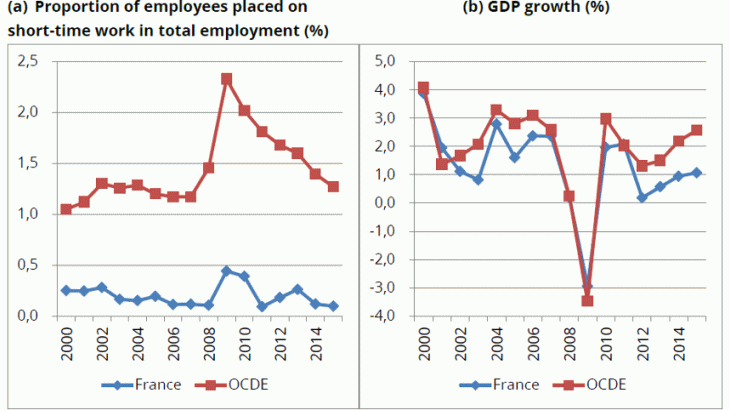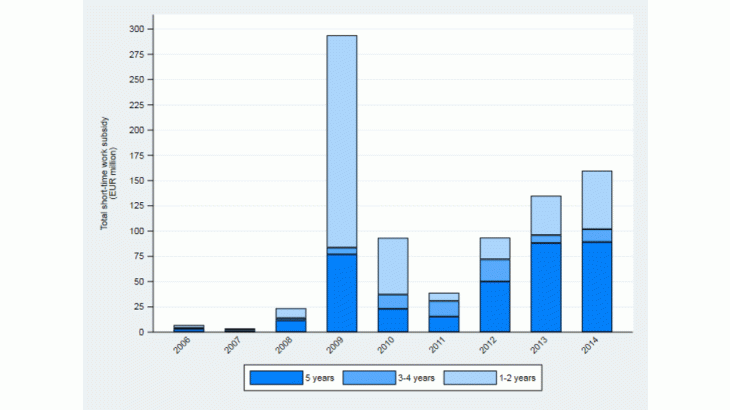Short-time work is an employment policy aimed at companies experiencing temporary difficulties. This mechanism sets out to protect jobs by temporarily reducing the number of hours worked by employees, while guaranteeing them for these unworked hours a compensation which is partly financed by the government.
Although this mechanism has existed in many OECD countries for a long time, it remained relatively unknown before the Great Recession of 2008-2009. During this period, several countries, notably Germany, introduced it or encouraged its use, which resulted in an increase in short-time work (see Chart 1). This coincided with a period of labour market resilience: the number of job losses was low with respect to the magnitude of the crisis. After the recession, some countries therefore decided to keep this scheme in place or even increase its generosity in order to support the economic recovery.
Short-time work is effective in times of crisis
Many studies highlight the positive effects of short-time work during crisis periods. This mechanism enables employees to keep their job and guarantees them a stable income. It allows companies to reduce the cost of labour and maintain their human capital. By avoiding redundancies, it improves the social climate and can contribute to bringing down unemployment insurance costs.
During the Great Recession of 2008-2009, Cahuc, Kramarz and Nevoux (2018) showed that short-time work was an effective tool for saving jobs. According to Balleer, Gehrke, Lechthaler and Merkl (2016), 466,000 jobs were saved thanks to short-time work in Germany during this period.
Short-time work may also lead to a decrease in hours worked and output
However, several studies have shown adverse effects associated with short-time work, which emerged both during and after the crisis periods. In order to optimise labour costs, financially viable companies may place some employees on short-time work who would have been kept on full-time contracts in the absence of compensation. In this case, the mechanism results in a decrease in the number of hours worked with no positive impact on employment.
Short-time work may also be used by companies experiencing prolonged economic difficulties to subsidise jobs that would otherwise be lost and whose employees would have been, in the absence of this mechanism, dismissed and possibly hired by more productive firms.
In the end, by reducing hours worked and impeding the efficient reallocation of labour, these windfall and displacement effects lead to a decline in aggregate output.
The adverse effects of short-time work stem partly from its financing
According to these studies, the adverse effects of short-time work stem partly from the structure of this mechanism and notably from its method of financing. Indeed, short-time work is generally financed by taxes and/or unemployment insurance. The contributions of firms to short-time work therefore do not depend on how much they use this mechanism (except in the United States and to a lesser extent in Italy). This financing system thus results in a financial transfer from firms not using it to firms using it. This subsidy results in these schemes being overused and poorly distributed vis-à-vis the social optimum. In this respect, Cahuc and Nevoux (2017) show that the current short-time work mechanism in France is not suitable for insuring employees and firms against seasonal fluctuations in activity. Since this mechanism relies exclusively on public financing, the lack of contributions from firms benefiting from it leads to an overconsumption and too frequent use of short-time work schemes. For instance, the 2012-2013 reforms of short-time work generated a financial transfer to firms repeatedly using this mechanism and facing major seasonal fluctuations. Yet, these public subsidies, inevitably financed by other sectors and companies, lead to output losses at the macroeconomic level, in that they impede the reallocation of labour affected by seasonal fluctuations towards more productive sectors of activity. The aggregate output loss associated with the current short-time work mechanism, vis-à-vis the social optimum, is estimated at 50% of the total short-time work subsidy granted to systematic users, or around EUR 40 million (see Chart 2).

